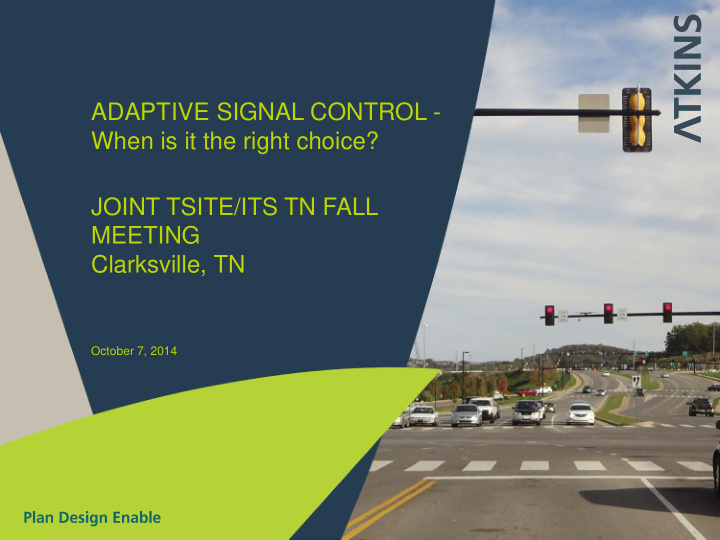



ADAPTIVE SIGNAL CONTROL - When is it the right choice? JOINT TSITE/ITS TN FALL MEETING Clarksville, TN October 7, 2014
Agenda ● What is adaptive signal control? ● Benefits ● Is adaptive signal control the right choice, then… ● Things to consider when selecting your system 2
What is Adaptive Signal Control? Technologies that capture current traffic demand data to adjust traffic signal timing to optimize traffic flow in coordinated traffic signal systems Capability of adjusting signal timing based on current conditions which may include adjustments to: Cycle Length Split Offset Phasing Modifications U.S. Dept. of Transportation – Federal Highway Administration 3
What is Adaptive Signal Control? ● How does adaptive signal control technology (ASCT) generally work? – Collect data in real-time from sensor systems to identify traffic conditions – Evaluate alternative signal timing strategies on a model of traffic behavior – Implement the “best” strategy according to some performance metric – Repeat … Implement Collect “Best” Real-Time Timing Data Strategy Evaluate Timing Strategies 4
Benefits of Adaptive Signal Control ● Reduced travel time along corridor ● Reduced intersection stop delay ● Increased average speeds ● Reduced fuel consumption ● Reduced emissions ● More efficient use of the roadway network ● Will not – Add capacity to the roadway – Eliminate saturation if roadway is over capacity 5
The first step… ● Use the system engineering process to determine your: – Needs – Issues – Problems – Objectives ● Develop functional requirements ● Don’t identify a solution and then look for a problem! 6
Criteria for Selection ● Variability – little to no clear consistency in traffic volumes over a period of time ● Predictability – Historical data cannot be used to define consistent traffic trends 7
Is ASCT the Appropriate Solution? Identify and Validate Issues •Do you have the staff and/or budget to operate and maintain? •Is traffic highly variable and unpredictable? •Are side street volumes low? •Is the volume-to-capacity ratio less than 1? YES NO ASCT might be the appropriate solution Identification of other Potential Solutions •Traffic Responsive System •Regularly Scheduled Signal Timing Optimization Identify Potential Candidate ASCT (System Engineering Process) Implement ASCT Evaluate ASCT (Before & After Study) 8
Adaptive Signal Control ● Not all ASCT are the same! – Detection type and placement – Central software – Algorithms – how they optimize signal operations – Hardware needs – Software features – Cost – both initial and long-term 9
Adaptive Signal Control Technologies ● SCOOT ● SCATS ● InSync ● RHODES ● OPAC ● ACS Lite ● Trafficware SynchroGreen 10
Differences ● Each vendor solution may have pros and cons: – How to accommodate over-capacity conditions – Quantity or specific type of detection needed – Value of side street movements – Phasing flexibility – Set up time – On-going maintenance – Preemption/prioritization accommodations ● Corridor vs. grid deployment 11
Agency impacts ● Initial cost ($30k to $65k / intersection) – Central software – Hardware – Detection – Communications ● Weekly maintenance (6 to 14 hours/week) ● Yearly operations and maintenance costs ($1k to $25k / intersection) ● Percent downtime (2% - 9%) ● Training (40 – 60 hours) 12
Things to consider ● Without vehicle detection – system won’t work ● Without communications – system won’t work ● Increased level of training for signal staff ● Larger up front cost when compared to more traditional methods ● Not always popular with your regular commuter who expects consistency day to day – education / awareness campaigns can help this 13
More things to consider ● Emergency preemption, pedestrian calls, and transit priority can create difficulties for some systems ● Working with a “black box” which may require heavy vendor reliance ● Steep learning curve ● Most adaptive systems require more detection than would be deployed for semi-actuated traffic control and traffic responsive plan selection methods 14
Lessons Learned ● Generally good return on investments ● Detection is everything ● Basic signal timing plans must still be developed for when detection fails ● Economy of scale ● Adaptive is not a cure-all ● Adaptive is not a set it and forget it ● Another tool for the traffic engineer’s toolbox 15
Points to Remember ● Don’t identify a solution and then look for a problem! ● Deployment should be based on sound engineering needs analysis ● Understand the long term implications of deployment ● Select the system that best addresses your problem and needs ● Go in with your eyes wide open ● Adaptive is not a cure-all – IT IS ANOTHER TOOL!! 16
So, when is Adaptive the right solution? ● And the answer is: SOMEWHERE BETWEEN NEVER AND ALWAYS! 17
Thank you Gerald Bolden, PE, PTOE Atkins North America Gerald.bolden@atkinsglobal.com 18
19
20
Understanding the limitations ● ASCT… – Over-saturation conditions – Pedestrian and bike volumes – Heavy reliance on detection and communications – Vendor support ● The agency… – Sufficient staff and budget to maintain the system – Long term commitment 21
Recommend
More recommend